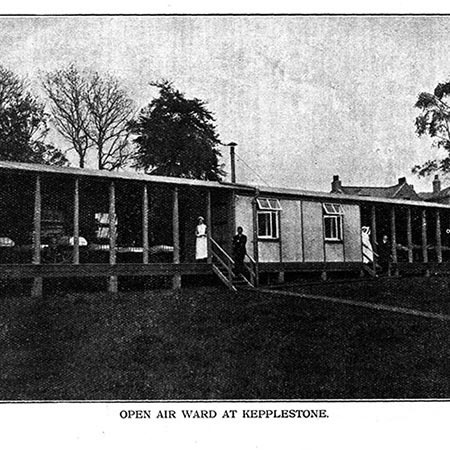Guest Collection Highlight by Fiona Watson, former NHS Grampian Archivist

Both the Infirmary and Dr Gray’s had agreements with the Admiralty to receive naval sick and wounded but within a few months they were admitting wounded soldiers as well. There was also a separate military hospital: the Aberdeen-based 1st Scottish General Hospital originally occupied several Aberdeen schools, and then in May 1915 took over the Oldmill poorhouse and adjoining hospital blocks (now Woodend Hospital). Many of the smaller hospitals across the north-east acted as auxiliary hospitals for the 1st Scottish, wounded soldiers sent back from the front being transferred there for further treatment or convalescence.
The Royal Aberdeen Hospital for Sick Children’s Hospital, then on Castle Terrace, decided to make a temporary move to Kepplestone House, fearing that proximity to the harbour exposed the hospital to risk of naval bombardment. The hospital directors, who already had outline plans for a new hospital, took the opportunity of the ground available at Kepplestone to try out a new kind of ward – a 26-bed open air ward. Although the ward was open to the fresh air on two sides, the hospital’s annual report assured the public that “with plenty of blankets and hot water bottles it is quite possible to keep the children warm even in the most bitter weather”. It was noted too that wounds healed more quickly and readily here than in the closed wards.
The increase in wages and in prices of all kinds of goods, brought about by the war, affected all hospitals. Many struggled to engage sufficient staff, and in 1915, Aberdeen Royal Asylum (now Royal Cornhill Hospital) had to increase its annual charges for patients’ board by almost 20%. The psychiatric effects of the war were less marked. The physician superintendent noted in January 1916 that “the war cannot be said to have yet had any remarkable influences on the number of admissions”, and two years later only four soldiers had been admitted for long-term treatment.
The First World War changed the future face of hospital provision for Aberdeen and the surrounding area. Had the war not started when it did, the Sick Children’s Hospital would have been built on land adjacent to Ashley Road School and there would have been a large public tuberculosis sanatorium on the outskirts of the city. The absence of such facilities was a major factor in the creation of the Joint Hospitals Scheme, which was launched after the war and led to the purchase and development of the Foresterhill site.
For more information please see NHS Grampian Archives.
